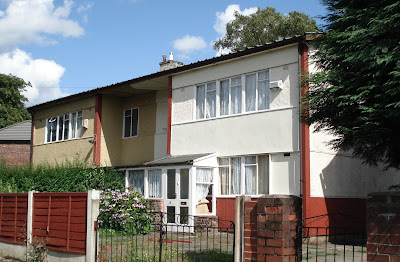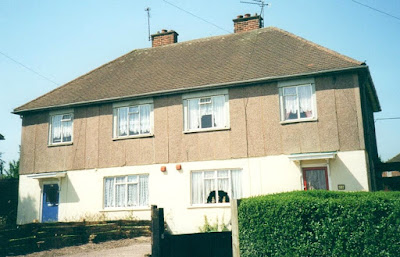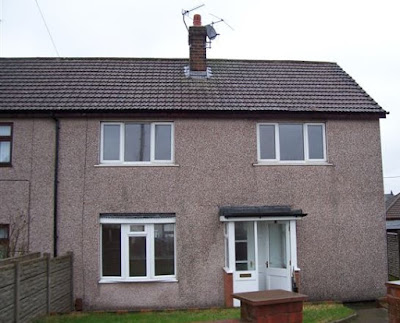Monday 11 June 2018
Crosswall Construction
The term ‘Crosswall’ relates to dwellings with brick party or gable end walls and timber frame front and rear elevations. They are often constructed on reinforced concrete raft type foundations. Roof structures are traditional timber beams and covered with tiles. The timber frame sections are often very thin. The front walls of the centre and right hand houses in the photograph below are partly clad with timber and part metal sheeting. Some may be clad with asbestos cement panels.
Many people may regard Crosswall construction as traditional, but it is fundamentally different to truly traditionally constructed houses, therefore is included in this series of blog posts about non-traditional construction.
Note that the front elevation of the property to left of the photograph has been modified. The brick and tile face and different window positions suggest the wall has been rebuilt in masonry.
Houses of Crosswall construction do not usually pose any significant problems for mortgage lending, but it is important that the external faces of the front and rear elevations are well maintained to reduce the risk of timber decay.
Sunday 10 June 2018
Howard Houses
Howard houses are a form of metal frame construction with exposed columns to the corners and thin concrete panel walls. They also have metal beams internally. Roofs are of a shallow pitch and covered with metal sheets. Asbestos cement panels may also be present.
Saturday 9 June 2018
Dyke CCC Houses
This is another large panel system and designated defective. The storey height concrete panels are easily visible at first floor level. The ground floor walls are rendered. Roofs are of the hip style. Problems include cracking between panels and metal reinforcement corrosion.
Friday 8 June 2018
Unity Houses
These have storey height reinforced concrete columns linked at ceiling level by metal beams spanning front to rear. They are faced externally with concrete panels. Unity houses are also designated defective due to cracking of the panels and corrosion of metal fixings.
Thursday 7 June 2018
Gregory Houses
The pair of semi-detached houses in the photograph below look like Cornish Type I at first glance, but they do not have any visible columns and beams. Have not inspected these myself, but they are consistent in appearance with Gregory houses. This is another form on non-traditional concrete construction, also designated defective.
Wednesday 6 June 2018
No-fines Concrete Houses
Another form of non-traditional construction in residential dwellings is no-fines concrete. The most common type is probably Wimpey No-Fines. There is also Laing Easi-form which is similar. Both are so named after the developers who created them.
The walls are formed from concrete poured into a timber frame. Once set, the timber is removed, leaving the solid walls cast in situ. The concrete was of a special type with an aggregate of round pebbles and no fine particles, hence the name 'no-fines'. The design resisted damp penetration as rainwater simply dripped off the pebbles and was unable to pass through to the interior due to the absence of any finer particles.
From the outside they look like typical post war semi detached houses with rendered walls. A matching rendered concrete chimney stack can be an identifying feature, but not always. Some of them have brick bays on the front. For a definite identification you need to look at the inner face of the gable end wall in the roof space. There you will see the round pebbles, as described above and shown in the photo below.
Usually the Wimpey no-fines is accepted for mortgage purposes. I have heard that the Easiform ones can be more difficult to mortgage due to known defects, but there are none in my area, so not had experience of them. If you've had dealings with a Laing Easiform house, it would be great if you could comment below.
If you've been enjoying this week's articles on non-traditional houses, please 'like' my page at Hallworth House Survey Education and click on 'get notifcations'. Future ones should then go to your timeline.
Tuesday 5 June 2018
Schindler Houses
When does an unmortgageable house fool the surveyor into thinking it is mortgageable?
The photo below is of a Schindler House. These are another form of non-traditional construction, with a hidden frame, but brick external walls and a traditional roof. Like the Airey, Cornish and Wates houses shown in earlier posts, they were designated defective and cannot be mortgaged.
The problem is that the frame is well hidden and they appear to be traditional brick structures from the outside and from within the roof space. Worse still, estates where they are located often also contain traditionally built counterparts side by side. They all look the same. There is a risk that the unwary surveyor will not recognise a Schindler house from a traditional house.
In the photo, the house on the left has re-built walls, indicating that it has been subject to a repair scheme. The house to the right has its original walls in situ. However, there are alternative repair schemes for this type of dwelling which can be performed from the inside, allowing the original walls to remain. Therefore it is possible that the right hand house has also been repaired.
If you enter a local authority estate where some of the houses have rebuilt walls, it is a sign that Schindler Houses may be present.
I'm going to rest the subject of non-traditional construction for now and move onto something else. If you've enjoyed this six part series, 'like' my page at Hallworth House Survey Education and click 'get notifications' to receive future posts of this kind on your timeline.
Subscribe to:
Posts (Atom)
Crosswall Construction
The term ‘Crosswall’ relates to dwellings with brick party or gable end walls and timber frame front and rear elevations. They are often con...
-
The term ‘Crosswall’ relates to dwellings with brick party or gable end walls and timber frame front and rear elevations. They are often con...
-
Another form of non-traditional construction in residential dwellings is no-fines concrete. The most common type is probably Wimpey No-Fines...
-
When does an unmortgageable house fool the surveyor into thinking it is mortgageable? The photo below is of a Schindler House. These are a...








